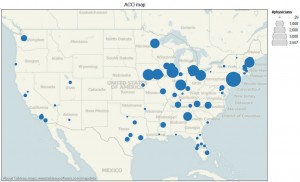 An ACO “heat map”
An ACO “heat map”
Robert Rowley, MD, Healthcare and health IT consultant, practicing family physician
Accountable Care Organizations (ACOs) are gaining momentum. These efforts, part of the 2010 Affordable Care Act (recently upheld by the Supreme Court), aim at building voluntary groups of doctors, hospitals and other healthcare providers in order to improve the quality and reduce the cost of health care (at least, to Medicare fee-for-service beneficiaries).
In December, 2011, 32 Pioneer Model ACOs were announced, followed by 6 Physician Group Practice Transition Demonstration organizations announced in January 2012. On April 1, an additional 27 ACOs entered into the Shared Savings Program, bringing the total number of ACOs at that time to 65.
On July 9, CMS announced 88 new ACOs, bringing the total to 153 organizations. Given that these organizations have yet to have any track record, it is speculative as to the actual number of patients to be served within ACOs (as opposed to being served by traditional providers in the same geographies outside those ACOs). However, CMS offers data that ACO applicants can use to calculate their Primary Service Area, based on 2010 claims data for outpatient and hospital services for the providers to be included in the ACO. Using these estimates, the ACOs are poised to serve over 2.4 million Medicare patients across the country.
Where are these ACOs located? Are there regional or geographic variations? Are some of them competitive with rival ACOs in the same area?
The data released on the 88 new ACOs in July do show the number of physicians participating in each organization, which allows a “heat map” of ACOs to be built. The earlier press releases from Medicare (about the 27 in April, and earlier) did not include data on the number of physicians in each of those earliest ACOs – but the current listing does.
ACOs vary in size from just 29 participating physicians up to 2,249 physicians for the largest one announced to date. The distribution of ACOs across the country (of the 88 most recently announced) can be seen graphically, where the size of the bubble represents the number of physician participants in the ACO:
Trends? There seems to be a preponderance of large ACOs in the Northeast and Midwest sections of the country. The West and the South have fewer, smaller ACOs to date. The biggest ones appear to be focused around large hospitals (Mount Sinai in New York leads the list), with universities and health plans being the organizing forces behind many of the other largest ones.
Certainly, the ACO movement is gaining momentum. These organizations will need novel types of Health IT infrastructures in order to do well. They will need to meet 33 quality measures, which are intended to ensure that the savings (which the ACO will keep a portion of) are achieved through the provision of care that is appropriate, safe and timely. The measures are grouped into categories, which include (1) care coordination, (2) patient safety, (3) preventive health services, (4) care for at-risk populations, and (5) experiences reported by patients and caregivers.
[Related Article: ACOs and Meaningful Use]
Given this, we are likely to see rapid growth in the Health IT sector for technology that supports ACOs and allows them to do what they are charged with. This sector growth may be similar to that seen in the Electronic Health Record (EHR) segment in the past 2 years spurred by Meaningful Use. If the EHR experience is any guide, the ACO-supporting sector will likely have a handful of large, legacy players that may dominate (and be criticized for being “old-school”), and an rising tide of smaller, innovative start-ups that challenge the sector with new ideas and approaches.
Like with EHRs, some of the larger or more established companies (likely coming from those vendors who support Health Information Exchanges) will offer “complete solutions” to ACOs, and smaller companies may offer more focused “modular components” that ACOs might need. Large ACOs might have different Health IT needs than the smaller ones, and may function with very different Health IT budgets.
[Related article: The biggest challenge for HIE is not technical]
If there is to be a filling-of-the-void of ACO-enabling Health IT products, interoperability with other modular components will be important. These standards may end up coming from industry, since government-mandated standards (seen for the EHR segment) does not have a formal structure, like it does with EHR Certification.
This will be an exciting area of opportunity for the Health IT industry. Expect it to be the biggest buzz at HIMSS 2013.
Robert Rowley is a practicing family physician and healthcare information technology consultant. From its inception through 2012, Dr. Rowley had been Practice Fusion’s Chief Medical Officer, having created the underlying technology in his own practice, and using that as the original foundation of the Practice Fusion web-based EHR. This article was first published on Dr. Rowley’s web site www.robertrowleymd.com.

